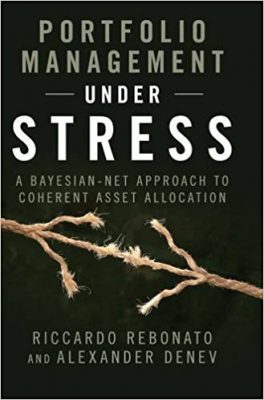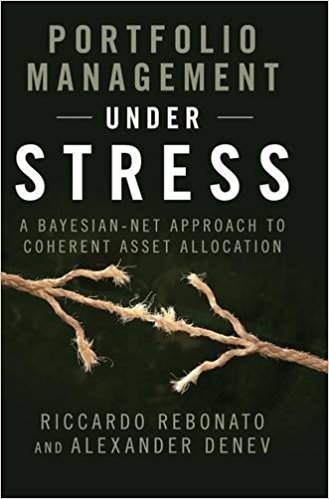 Authors: Riccardo Rebonato and Alexander Denev
Authors: Riccardo Rebonato and Alexander Denev
Publisher: Cambridge University Press – 491 pages
Book Review by: Sonu Chandiram
How does an investor or trader do asset allocation in his or her portfolio to protect it from market distress and volatility that could bring the values of his holdings downward? How does he or she apportion holdings in different asset classes so that when prices drop in one or more asset class, the entire portfolio still remains on a relatively stable footing and the overall value of the portfolio is not severely affected?
In this book of nearly 500 pages, the two authors, who have had years of experience in portfolio risk management at large financial institutions, show you how to manage your portfolio of stocks, mutual funds, bonds, and other types of assets, especially when one or several sectors of the market are under stress, or may be so in the future?
Various subjects relating to asset management are covered in this resource, and to give you a broad overview of what is covered, we have drawn below an outline for presenting data and discussion of the main subjects, as represented by the titles of the 10 chapters of this book:
List of Figures
List of Tables
Preface
- Part I. Our Approach in its context
- Part II. Dealing with extreme events
- Part III. Diversification and subjective views
- Part IV. How we deal with exceptional events
- Part V. Building Bayesian nets in practice
- Part VI. Dealing with normal-times returns
- Part VII. Working with the full distribution
- Part VIII. A framework for choice
- Part IX. Numerical implementation
- Part X. Analysis of portfolio allocation
The word ‘Bayesian’ as used in the title of this book and throughout, refers to Thomas Bayes, an English statistician, philosopher and Presbyterian minister who lived from 1701 to 1761. He was educated at the University of Edinburgh, and wrote An Essay Toward Solving a Problem in the Doctrine of Chances.
Bayes proposed a theorem in the field of statistics in which the probability of an event occurring was based in terms of degrees of belief known as Bayesian probabilities.
Today, the Bayesian theorem is used to update (increase or decrease) the probability for a hypothesis as more evidence and information becomes available. The Bayesian inference is an important technique in modern-day statistics, especially in mathematical statistics, and is widely accepted as providing a sound theoretical foundation.
What makes this book an important one in the field of asset allocation is that, as stated in the initial page describing this book (underscoring is ours) “the authors place causal explanations, rather than association-based measures such as correlations, at the core of their argument, and insights from the theory of choice under ambiguity aversion are invoked to obtain stable allocation results.”
Two other characteristics of this book make it a valuable one for those who manage their clients’ portfolios, for researchers, or for those who want to use this book for managing their own portfolio:
- Step-by-step guidelines are included to allow readers to grasp the full implementation of this approach
- Case studies provide provide clarification
The authors provide an outline of their approach to portfolio diversification on pages 6-7.We quote them briefly here (emphasis in italics ours) but urge readers to read the book in its entirety to understand the process thoroughly. They believe (we quote them) that:
- Correlations are relatively stable during normal market conditions, and can be profitably extracted using traditional statistical (frequentist) techniques
- In conditions of market turmoil the codependence among changes in asset price is radically altered. Along with many econophysicists, we do believe that extreme events are ‘in a class of their own’.
- We have found little empirical support for the belief that extreme events leave a regular invariant ‘signature’ in the distribution of joint returns We believe instead that each crisis unfolds according to its own idiosyncratic dynamics.
- We believe that establishing these crisis-specific co-dependencies is very difficult. But we also believe that we can go a long way towards building a sound understanding of how asset prices may move in stress conditions by injecting causal information about how the world works
While they state “we put diversification at the very heart of our approach (to portfolio management)” Rebonato and Denev also point out: “we are acutely aware of a problem, however.” Then they invoke the words of PIMCO co-CEO Mohamed A. El-Erian written after the 2007-2009 financial crisis:
“Recent developments will serve to further highlight the danger of being overly committed to an historical policy portfolio whose rigid backward-looking characterization no longer corresponds to the reality of today and tomorrow…
…with its reduced (or to be more precise. reduced-form) analytical foundation now subject to some motion, it will become even more difficult to rely just on traditional portfolio diversification as both sufficient and necessary to deliver high returns and mitigate risk. Diversification will remain necessary, but a lot more attention will be devoted to the appropriate specification of tail scenarios and tail hedges…”
In sum, this is a pioneering work on the subject of portfolio construction and asset diversification, and long-term management, taking into account importantly, that in extreme financial events, normal rules do not necessarily apply, and one must invoke and use Bayesian statistical models and other information to achieve the desired returns.
Rebonato and Denev have made a valuable contribution to the portfolio management literature with this innovative work based on a strong mathematical foundation. Our hats off to them !
Authors:
Riccardo Rebonato is the Global Head of Rates and Foreign Exchange Analysis at PIMCO, and a visiting lecturer in Mathematical Finance at Oxford University (OCIAM). He has previously held positions as Head of Risk Management and Head of Derivatives at several major international trading institutions.
Dr. Rebonato was on the Board of the International Swaps and Derivatives Association (ISDA) from 2002 to 2011, and still serves on the Board of the Global Association of Risk Professionals or GARP from 2001 to the present. He is the author of several books on finance and an editor of several journals (International Journal of Theoretical and Applied Finance, Journal of Risk, Applied Mathematical Science, Journal of Risk for Financial Institutions).
Alexander Denev is a senior team leader in the Risk Models department at the Royal Bank of Scotland. He specializes in Credit Risk, Regulations, Asset Allocation and Stress Testing, and has previously worked in management roles at European Investment Bank, Societe Generale, and National Bank of Greece.







